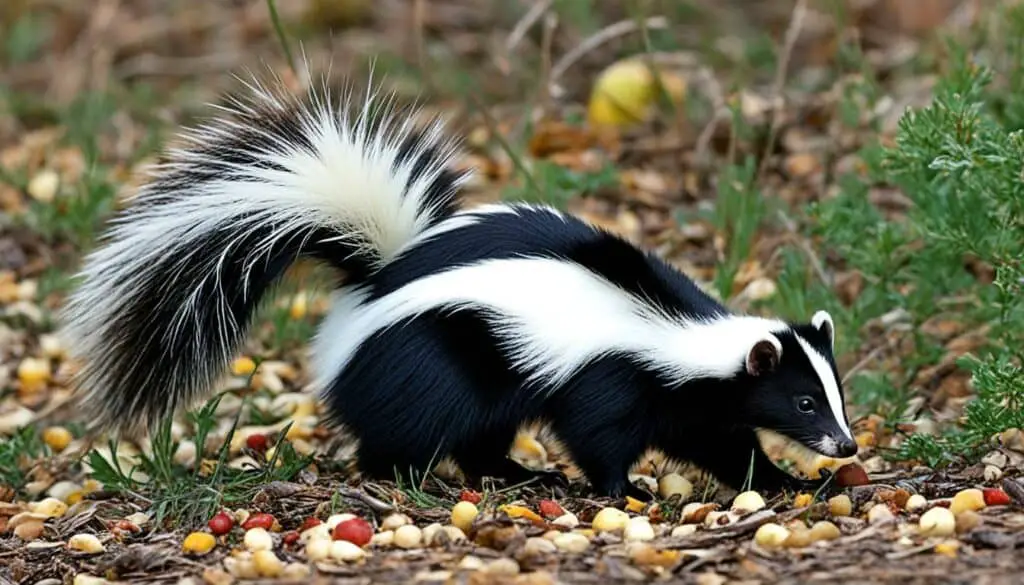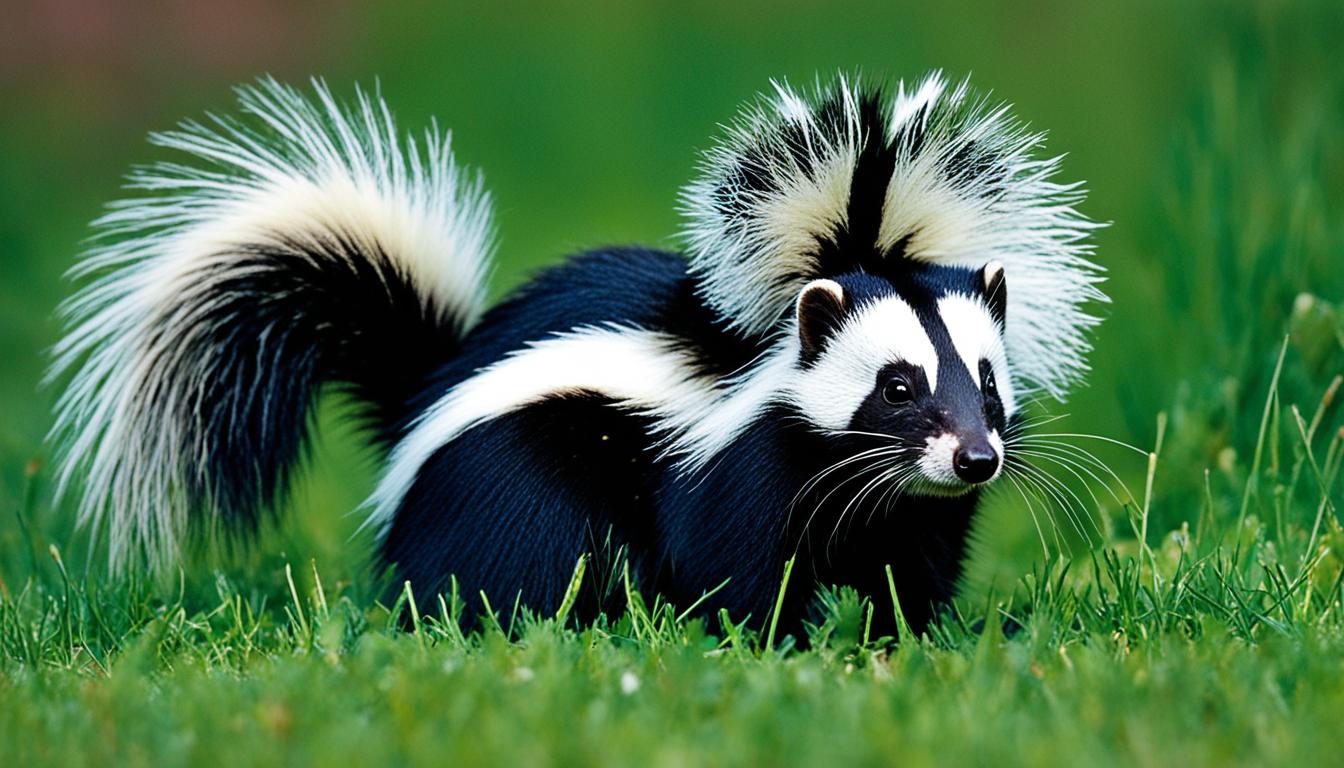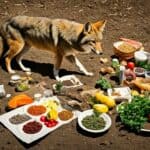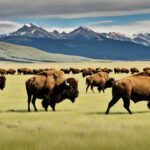Ever thought about how what skunks eat helps them survive and fit into nature? It’s key to know what a striped skunk eats to understand its place in the ecosystem. They eat a mix of plants and animals because they are omnivores.
Skunks have a hard time surviving, especially when they are young. This might make them less picky about what they eat. Young skunks follow their mother’s lead on finding and catching food after they stop nursing. This gives us a clue that skunks learn what to eat.
Introduction to Striped Skunk’s Dietary Habits
Striped skunks eat a wide variety of foods. They can live in many places because they can find food easily. It’s important to know how their diet changes with the seasons.
Overview of Striped Skunk Diet
Skunks will eat almost anything. They like insects, small animals, fish, and plants. This variety shows they can take advantage of whatever is around them.
Significance of Seasonal Changes
In warm months, skunks focus on bugs and plants. These are easy to find then. But as it gets cold, they eat more small mammals. This pattern helps them survive all year round.
| Season | Primary Food Sources |
|---|---|
| Warm Months | Insects, Fruits, Nuts |
| Cold Months | Small Mammals |
Omnivorous Nature of Striped Skunks
Skunks are omnivores, which means they eat both animals and plants. This diet proves how adaptable they are. They can survive by eating from a wide range of sources.
Animal-Based Diet
Skunks eat a lot of animal foods. This includes insects, small mammals, and fish. Insects are key, providing protein for skunks. They also rely on small mammals when finding food is hard, like during the cold. Fish give them important nutrients in their varied diet.
Plant-Based Diet
Skunks eat plants too, like fruits, nuts, and grasses. Fruits give them essential vitamins and sugars. Nuts offer fats and proteins. Grasses and other plants help their digestion and add more nutrients. This plant diet works together with their animal foods to keep them healthy and varied.
| Food Source | Examples | Nutritional Benefit |
|---|---|---|
| Animal-Based | Insects, small mammals, fish | Protein, essential nutrients |
| Plant-Based | Fruits, nuts, grasses | Vitamins, fats, fibers |
What Influences Striped Skunk Feeding Habits?
Striped skunk eating habits are largely shaped by where they live. The type of home they have and how close they are to water matter. They also eat what’s around them. This means they take on different diets, eating from old burrows to hunting in forests and fields.
Environmental Factors
A skunk’s surroundings are key to its eating habits. The type of area it lives in, such as a forest or town, as well as being near water, affect what it can find to eat. These aspects also decide what food is available at different times, which shapes the skunk’s diet and health.
Availability of Food Sources
The food around a skunk changes what it eats. They look for what’s easy to find, because they can eat many things. Skunks can find food in many places. This shows that skunks can eat what’s there to get the nutrients they need.
Insect Consumption by Striped Skunks
Striped skunks love eating insects because they are rich in protein. This diet helps them get all the nutrition they need. Plus, it’s a key part of how they survive.
Types of Insects Eaten
Beetles, bees, and many small invertebrates form the main part of a skunk’s diet. Not only are these insects everywhere, but they’re also full of important nutrients. This includes proteins and fats that skunks need to live.
Foraging Techniques for Insects
Skunks are really good at finding insects. They use their powerful front legs and sharp claws to dig. By digging, they find insects hiding beneath the ground. This skill is how they find food every day. It shows how hard they work to eat these crucial meals.
Their diet of insects proves how well they can adjust. Their sharp foraging skills let them live well in many places. They make the most out of their natural talents.
Small Mammals as Part of Skunk Diet
In cold months, small mammals are vital for striped skunks. They offer important nutrients needed for the skunks’ survival. When insects are not around, these mammals become the main food source.
Common Prey
Skunks often target mice, shrews, and chipmunks. These animals are a major protein and fat source. Skunks adjust their hunting based on the availability of these small creatures.
Hunting Methods
To hunt, skunks use their sharp sense of smell and move quietly. They mainly hunt at night to avoid other predators and to be more successful. This shows how they adapt and use their skills in different ways to stay alive.
| Prey Type | Hunting Method | Nutritional Value |
|---|---|---|
| Mice | Stealth and pounce | High in protein and fat |
| Shrews | Scent tracking | Rich in essential nutrients |
| Chipmunks | Burrow digging | Good source of energy |
Seasonal Variations in the Diet of Striped Skunks
Based on the seasons, striped skunks change what they eat a lot. This change is key for their survival and being able to live in different places.

Warm Months
Striped skunks in the warm months eat mostly insects and some plants. They find lots of beetles, grasshoppers, and more insects at this time. Fruits like berries and apples are their favorites too, along with roots and other plants.
Cold Months
In colder months, striped skunks change to eating small mammals. They can’t find many insects, so they focus on catching mice and shrews. This change in diet helps them survive the winter by getting the right nutrients.
| Season | Primary Food Sources |
|---|---|
| Warm Months | Insects, Fruits, Roots, Plant Matter |
| Cold Months | Small Mammals (Mice, Shrews) |
Role of Fruits and Vegetables in Skunk Nutrition
Fruits and vegetables are key for skunk’s nutritional needs. They include vitamins and minerals necessary for good health in striped skunks.
Types of Fruits and Vegetables
Striped skunks love a range of fruits and vegetables. They eat berries, apples, and root veggies like carrots. This plant-based skunk diet offers lots of vitamins, minerals, and fiber that helps with digestion.
Importance of Plant Matter
Adding nuts, leaves, and grasses is vital for skunks to eat healthy. They get a balanced diet from different food sources. This keeps them strong and healthy.
Striped Skunk Scavenging Behaviors
Striped skunks have varied feeding habits beyond just hunting. They show great skill in scavenging, which helps them survive in different places.
Opportunistic Feeding
As opportunistic eaters, skunks eat a wide range of things. They don’t rely only on catching live animals. They eat what’s easy to find, such as food left by others or thrown away by people. This helps them live well in any area, be it natural or human-made.
Common Scavenged Foods
In a skunk diet, you’ll find roadkill, pet food leftovers, and fruit that’s dropped from gardens. These scavenging habits keep them well-fed even when their usual food is scarce. This part of their eating strategy means they can eat both plants and animals, which helps them cope with changes in their environment.
| Type of Scavenged Food | Description |
|---|---|
| Carrion | Animal carcasses found in the wild or near human activity |
| Discarded Human Food | Leftovers from picnic areas, trash bins, and outdoor activities |
| Pet Food | Food left outside for domestic pets, often found in backyards |
| Garden Produce | Fallen fruits and vegetables from household gardens |
In the end, the skunks’ scavenging habits show their skill at finding food in many places. This allows them to live well in all types of environments, like the wild or near our homes.
Impact of Human Activity on Striped Skunk Diet
Human actions have greatly changed what striped skunks eat. The fast growth of cities and large farms has altered their homes. New food has come in, but the old sources have gone down, pushing skunks to look for food in new ways.
Skunks in cities often feed off trash. They look for leftovers in garbage cans, showing how they can adjust. This shows the strong link between people and skunk eating habits. It also shows that skunks can live well in busy places.
Skunks also get food from farms, like fruits and veggies. This helps add to what they eat. But living near people means they might face dangers like pesticides. Despite this, skunks show they can find ways to live in a world shaped by humans.
FAQ
What is the diet of a striped skunk?
A striped skunk’s diet is broad. It includes both plant and animal foods. They eat insects, small mammals, and fruits. They also eat carrion, which is dead animals, as part of their diet.
How do seasonal changes affect the diet of striped skunks?
In warmer months, striped skunks eat more insects and plants. They get the extra nutrients they need during this time. When it’s colder, they switch to eating more small mammals.
What types of animal-based foods do striped skunks eat?
Striped skunks enjoy a wide range of animal foods. This includes insects like beetles. They also eat small mammals such as mice and shrews.
What plant-based foods do striped skunks prefer?
They like to eat fruits, nuts, leaves, and grasses. These plants give them important vitamins and minerals. Roots are also on their menu.
How do environmental factors influence the feeding habits of striped skunks?
Where a skunk lives affects what it eats. Food around them like at water sources is vital. Skunks eat what’s available, changing their diet based on the season.
What techniques do striped skunks use to forage for insects?
Skunks are good at finding insects in the ground. Their digging skills and determination help them find bugs. This adds a lot of protein in their diet.
What are common prey items for striped skunks, and how do they hunt them?
Skunks often hunt small mammals like mice and shrews. They find these prey using their excellent sense of smell. They hunt at night, taking advantage of their ability to go unnoticed.
How does the diet of striped skunks change during warm months?
In warmer times, skunks focus mostly on insects. They also eat plenty of plants. This shift happens because there’s more of these foods available.
What dietary adjustments do striped skunks make in colder months?
When it gets cold, skunks turn to eating more small mammals. This adjustment happens because insects are harder to find. It helps them get the nutrients necessary for winter.
What roles do fruits and vegetables play in the nutrition of striped skunks?
Fruits, nuts, and vegetables are vital for skunk health. They provide important vitamins and minerals. These plant foods keep their diet well-rounded.
What are common scavenged foods for striped skunks?
Skunks scavenge a lot. They may eat dead animals, scraps from other hunters, or even human trash. Their ability to eat various things makes them suited to many places.
How has human activity influenced the diet of striped skunks?
People changing the land has affected skunk diets. Now they might eat trash or food from farms. This shows how humans and skunks’ lives are connected.







